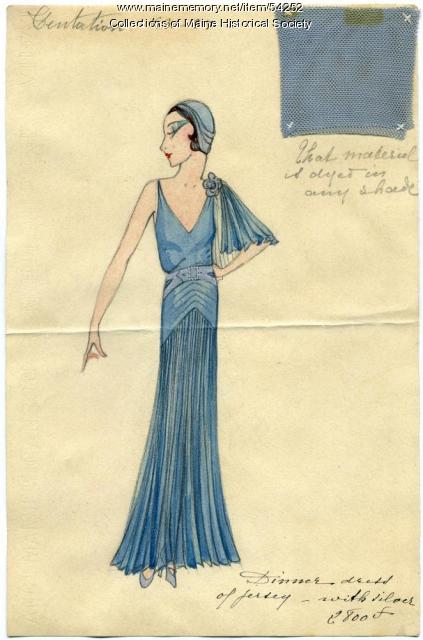Keywords: War Bonds
- Historical Items (38)
- Tax Records (0)
- Architecture & Landscape (0)
- Online Exhibits (16)
- Site Pages (21)
- My Maine Stories (1)
- Lesson Plans (0)
Online Exhibits
Your results include these online exhibits. You also can view all of the site's exhibits, view a timeline of selected events in Maine History, and learn how to create your own exhibit. See featured exhibits or create your own exhibit
Exhibit
World War I and the Maine Experience
With a long history of patriotism and service, Maine experienced the war in a truly distinct way. Its individual experiences tell the story of not only what it means to be an American, but what it means to be from Maine during the war to end all wars.
Exhibit
Civil War Soldiers Impact Pittsfield
Although not everyone in town supported the war effort, more than 200 Pittsfield men served in Civil War regiments. Several reminders of their service remain in the town.
Exhibit
When America entered the Great War in 1917, the government sent out pleas for help from American women, many of whom responded at the battle front and on the home front.
Exhibit
Home Ties: Sebago During the Civil War
Letters to and from Sebago soldiers who served in the Civil War show concern on both sides about farms and other issues at home as well as concern from the home front about soldiers' well-being.
Exhibit
Shaarey Tphiloh, Portland's Orthodox Synagogue
Shaarey Tphiloh was founded in 1904 by immigrants from Eastern Europe. While accommodating to American society, the Orthodox synagogue also has retained many of its traditions.
Exhibit
Port of Portland's Custom House and Collectors of Customs
The collector of Portland was the key to federal patronage in Maine, though other ports and towns had collectors. Through the 19th century, the revenue was the major source of Federal Government income. As in Colonial times, the person appointed to head the custom House in Casco Bay was almost always a leading community figure, or a well-connected political personage.
Exhibit
Student Exhibit: Somerset Railroad
The Somerset Railroad was completed in 1872. It started out as a dream to link the Maine Coast with Canadian businesses to the north. It ran from the North Woods around Moosehead Lake down to Southern Maine and back again for 56 years.
Exhibit
Cosmopolitan stylings of Mildred and Madeleine Burrage
Born in Portland, sisters Mildred Giddings Burrage (1890-1983) and Madeleine Burrage (1891-1976) were renowned artists and world travelers. Mildred's experiences studying painting in Paris and Italy, and the sisters' trips to Mexico and Guatemala inspired their artwork and shared passions for cosmopolitan and stylish attire. Housed at Maine Historical Society, The Burrage Papers include selections of original advertising drawings called "line sheets" from Parisian fashion houses dating from 1928 to 1936. Images of Madeleine's gemstone jewelry and Mildred's artwork accompany intimate family photographs of the sisters.
Exhibit
The Establishment of the Troy Town Forest
Seavey Piper, a selectman, farmer, landowner, and leader of the Town of Troy in the 1920s through the early 1950s helped establish a town forest on abandoned farm land in Troy. The exhibit details his work over ten years.
Exhibit
Prohibition in Maine in the 1920s
Federal Prohibition took hold of America in 1920 with the passing of the Volstead Act that banned the sale and consumption of all alcohol in the US. However, Maine had the Temperance movement long before anyone was prohibited from taking part in one of America's most popular past times. Starting in 1851, the struggles between the "drys" and the "wets" of Maine lasted for 82 years, a period of time that was everything but dry and rife with nothing but illegal activity.
Exhibit
In the early 1600s, French explorers and colonizers in the New World quickly adopted a Native American mode of transportation to get around during the harsh winter months: the snowshoe. Most Northern societies had some form of snowshoe, but the Native Americans turned it into a highly functional item. French settlers named snowshoes "raquettes" because they resembled the tennis racket then in use.
Exhibit
A Riot of Words: Ballads, Posters, Proclamations and Broadsides
Imagine a day 150 years ago. Looking down a side street, you see the buildings are covered with posters and signs.
Exhibit
Longfellow: The Man Who Invented America
Henry Wadsworth Longfellow was a man and a poet of New England conscience. He was influenced by his ancestry and his Portland boyhood home and experience.
Exhibit
Best Friends: Mainers and their Pets
Humans and their animal companions began sharing lives about twenty-five thousand years ago, when, according to archaeological evidence and genetic studies, wolves approached people for food scraps. As agriculture grew and people began storing grains around ten thousand years ago, wild cats helped keep rodents at bay and feline populations thrived by having a steady food source. Over time, these animals morphed into the dogs and cats we know today, becoming our home companions, our pets.
Exhibit
Maine Eats: the food revolution starts here
From Maine's iconic lobsters, blueberries, potatoes, apples, and maple syrup, to local favorites like poutine, baked beans, red hot dogs, Italian sandwiches, and Whoopie Pies, Maine's identity and economy are inextricably linked to food. Sourcing food, preparing food, and eating food are all part of the heartbeat of Maine's culture and economy. Now, a food revolution is taking us back to our roots in Maine: to the traditional sources, preparation, and pleasures of eating food that have sustained Mainers for millennia.
Exhibit
Since the establishment of the area's first licensed hotel in 1681, Portland has had a dramatic, grand and boisterous hotel tradition. The Portland hotel industry has in many ways reflected the growth and development of the city itself. As Portland grew with greater numbers of people moving through the city or calling it home, the hotel business expanded to fit the increasing demand.
















